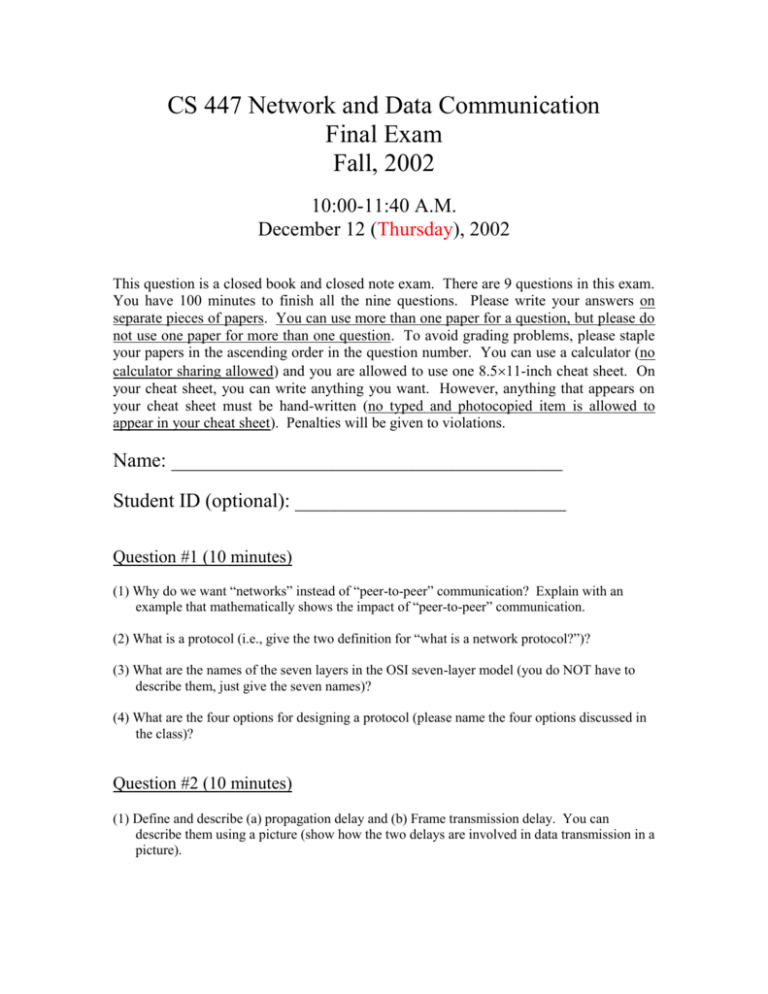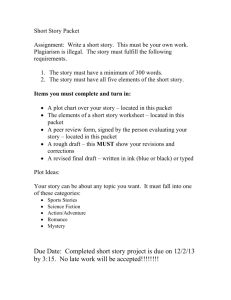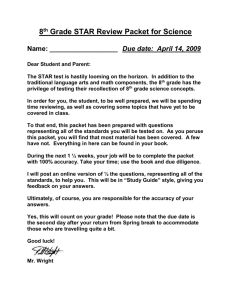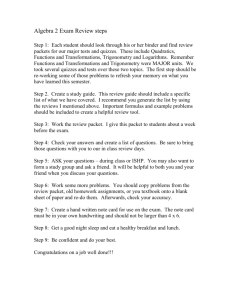CS447_Fall2002_RealF..
advertisement

CS 447 Network and Data Communication Final Exam Fall, 2002 10:00-11:40 A.M. December 12 (Thursday), 2002 This question is a closed book and closed note exam. There are 9 questions in this exam. You have 100 minutes to finish all the nine questions. Please write your answers on separate pieces of papers. You can use more than one paper for a question, but please do not use one paper for more than one question. To avoid grading problems, please staple your papers in the ascending order in the question number. You can use a calculator (no calculator sharing allowed) and you are allowed to use one 8.511-inch cheat sheet. On your cheat sheet, you can write anything you want. However, anything that appears on your cheat sheet must be hand-written (no typed and photocopied item is allowed to appear in your cheat sheet). Penalties will be given to violations. Name: _______________________________________ Student ID (optional): ___________________________ Question #1 (10 minutes) (1) Why do we want “networks” instead of “peer-to-peer” communication? Explain with an example that mathematically shows the impact of “peer-to-peer” communication. (2) What is a protocol (i.e., give the two definition for “what is a network protocol?”)? (3) What are the names of the seven layers in the OSI seven-layer model (you do NOT have to describe them, just give the seven names)? (4) What are the four options for designing a protocol (please name the four options discussed in the class)? Question #2 (10 minutes) (1) Define and describe (a) propagation delay and (b) Frame transmission delay. You can describe them using a picture (show how the two delays are involved in data transmission in a picture). (2) Describe what will happen when an incoming connection request from a client happens for “accept ( )” system call (there are two activities in this function). (3) What are the five key words to describe “socket” (just give the five key words – you do NOT have to describe them)? (4) What are the packet-switching networks? (i.e., define “packet switching networks”). Define packet switching network using no more than three lines of sentence(s). Question #3 (10 minutes) (1) Which layers are composed of the external view? (2) What are the three different types of MAC (show them as were shown in the classroom)? – You do NOT have to describe them (just give the three names). (3) Describe repeater, hub, bridge and router (“describe” so that the differences are clear). You need to describe each of the four different types of network devices using up to two sentences and your answer can not be more than three lines for each device – make sure to include the keywords that describe each device. (4) What is “sub-network” (i.e., give the definition) and why we use it? Question #4 (10 minutes) (a) The three-layer routing in the Internet actually consists of four different routing layers. What are they (name each of the four routing layers) and describe the essence of each routing layer using at most several words. (b) ISA assumes four different classes of network traffic. What are they? Give an example of typical network application for each of the four different combinations of the network traffic classes. Give your solution using a table (as was done in the classroom). Question #5 (10 minutes) This is one of the suggested exercise questions: A transport-layer message consisting of 1500 bits of data and 200 bits of header is sent to an internet layer, which appends another 200 bits of header. This is then transmitted through two networks, each of which uses a 32-bit packet header. The destination network has a maximum packet size of 400 bits. Assume that the packet size of the first network is large enough so that there will not be any fragmentation necessary for the packet. How many bits, including headers, are delivered to the network-layer protocol (i.e., to the internet layer) at the destination? Question #6 (10 minutes) In the figure below, frames are generated at node A and sent to node C through node B. Determine the minimum transmission rate required between nodes B and C so that the buffers of node B are not flooded, based on the following: The data rate between A and B is 200 Kbps. The propagation delay is 5ms/Km for both links. There are full-duplex links between the nodes. All data frames contain 1000bits; ACK frames are separate frames of negligible length. Between A and B, a sliding-window protocol with a window size of 3 is used. Between B and C, stop-and-wait flow control is used. There are no errors. Note: Show your work (formula, intermediate calculation and figures (if you want)). A solution without showing intermediate procedures will result in only 4 points (out of 10) even though the answer is correct. Question #7 (10 minutes) This is a question from a previous midterm exam: Two neighboring nodes (A and B) use a sliding-window flow control protocol with a 4-bit sequence number. As the ARQ mechanism, Go-Back-N is used with a window size of 8. Assuming A is transmitting and B is receiving, show the window positions (location of the windows at A) for the following successions of events: (a) After A sends frames, 0 through 6 and B acknowledges 0 through 4 and the ACKs are received by A. (b) After A sends frames, 7 through 10 and B acknowledges 8 (cumulative ACK) and the ACK is received by A. (c) After A sends frames up to frame 16 Question #8 (15 minutes) For a token-ring network with the following assumptions: The transmission rate = 1000 Mbps (= 1 Gbps) There are 75 nodes connected to the token-ring network Each physical link is 15 meters At each repeater, two-bit delay is inserted for signal formation and amplifying Frame (= packet) size is 100 bytes The signal propagation speed is 300,000 Km/sec. Ignore the delay to pass the token to the next neighbor Assume 1K = 1000, 1M = 1000K and 1G = 1000M (to simplify your work) Question #1: What is the possible maximum utilization of this token-ring network? Note (for Question #1 only): Show your work (formula, intermediate calculation and figures (if you want)). A solution without showing intermediate procedures will result in a very low grade. Question #2: To increase the utilization without replacing any network hardware, what can you do? Give a solution (you do NOT have to write a paragraph to answer this question. Just give your idea using no more than three-line sentence(s). Question #3: If you decrease the transmission rate, what do you expect for the utilization (assuming that all other assumptions remain the same)? – You do NOT have to calculate anything (if you want, you could, though), just use your intuition. Question #9 (15 minutes) Suppose there is a bus-based LAN network (such as 10-BASE5 IEEE 802.3 Ethernet) with the following assumptions: The transmission rate is 100 Mbps. The network segment length is 500 meters. Question #1: What is the minimum packet size (total packet size – including both the packet header and user data) to use CSMA/CD in bytes? Note that the packet size must be the number of bytes in an integer. Question #2: How much time will CSMA/CD save from CSMA for the network for the minimum-size packet you calculated in Question #1? Use the following assumptions to find the answer: The local timer expiration is (RTT) for CSMA where = 1.5. RTT = “Round Trip Time” (= the possible longest RTT in this network). Your host can start re-transmission without any delay whenever it is supposed to do so (for both CSMA and CSMA/CD). You can assume that a collision will never occur for re-transmitted packets (packets will be always successfully transferred on the first re-transmission) – this is logically impossible, but use this assumption to simplify your work. “How much time” means the time after a packet is first transmitted until an ACK comes back from the receiver. Ignore the transmission delay for the ACK message at a receiver Assume 1K = 1000, 1M = 1000K and 1G = 1000M (to simplify your work) The signal propagation speed is 300,000 Km/sec. CS 447-Network and Data Communication, Final Exam, December 12, 2002








